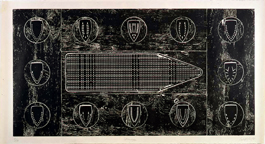home | metro silicon valley index | the arts | visual arts | review

Photograph Courtesy of Alexander and Bonin, New York. Photo by D. James Dee, N.Y.
Stowage: Willie Cole's woodblock print connects the commonplace to a historical tragedy.
Man of Irons
Willie Cole recycles the familiar into visions of surprise at Cantor Arts Center show
By Michael S. Gant
NEW JERSEY artist Willie Cole redeems consumer detritus. Blessed—and that's the word he would use—with an abandoned cache of old hair dryers, Cole envisages the white plastic, gun-shaped blowers as raw material for unexpected transformations. He assembles stacked and dissected dryers into a grimacing Asian god in Wind Mask East, with circular vent holes for eyes and the upside-down barrel for a nose. With photocopied images of this sleek unit, Cole pastes together a Shiva-armed bird deity with an "on-off" beak in Collage I.
Cole works this same kind of magic with a few pieces of bicycle frames in Sears Ross tji wara, in which inverted wheel shafts become antelope antlers. Bulbous sections of porcelain fixtures fit together like a nude sumo wrestler in Pleasure.
I first saw Cole's work in the "Domestic Odyssey" show at the San Jose Museum of Art three years ago. Leveraging a single object into a startling multiple, he screwed together hundreds of women's shoes—high heels pointing out—into a chair that looked as formidable as a porcupine La-Z-Boy and jabbed at Imelda Marcos with its title: Made in the Philippines II.
Another take on this witty idea turns up in "Anxious Objects," a major survey of Cole's work since the late '80s, now at the Cantor Arts Center at Stanford. This version of Made in the Philippines, constructed from a stash of thrift-store shoes that Cole bought by the pound, reveals even more clearly a pun that resonates throughout Cole's work: this chair literally bares its "soles/souls."
Another common household object that attracts Cole also has a sole: the iron, with its metal sole plate. The pointed-arch shape reminds Cole of boats, especially small vessels that might be used by fleeing refugees. The distinctive patterns of holes in the plates of steam irons, juxtaposed onto images of Cole's face, look like the scarification marks of African tribesmen. Evoking Cole's African American heritage, they are eye holes into the soul. The iron is nothing without the ironing board—a crucial leap. Cole connects the image of the ironing board as an elongated, perforated rectangle with a point prow to the infamous outline of the slave ship Brookes, with its cargo of bodies tightly packed like cordwood.
The ironing board first appears in Household Find (1990), where Cole embeds it under Plexiglas in a coffin shape surrounded by rusting tin ceiling sheets. Later, in the mammoth woodblock print Stowage (1997), the outline of the board is surrounded by 12 talismanic sole plates, each representing souls from 12 African tribes sold into slavery. Eventually, the iron and its board symbolizes the domestic servitude of generations of African American women. These irons turn up in the works of other artists. African American Bettye Saar, in I'll Bend but I Will Not Break (1998), stamps the Brookes slave-ship image onto a wooden ironing board. Iranian photographer Shadi Ghadian (who also showed at Domestic Odyssey) makes portraits of imaginary women in chadors with household objects in place of faces—most telling, the bottom of a steam iron.
But the irons are not always tools of submission. In Water Window Female Iron Figure, Cole welds together the shiny aluminum shells of irons into an African goddess, bent at the knees, wrapped neck and waist in blue and black insulated cords, and bristling with four metal snapping jaws on her head.
Cole has a keen sense of how to translate traditional African tribal motifs into a modern idiom. The link can be seen in the Cantor's gallery of African art, which includes an east Nigerian helmet mask adorned with what looks like steam-iron holes, and a small mask from Gabon in the same pointed-arch shape of a sole plate.
ANXIOUS OBJECTS: WILLIE COLE'S FAVORITE BRANDS shows through Jan. 6 at the Cantor Arts Center, Stanford University. Open Wednesday–Sunday, 11am–5pm, till 8pm Thursday. Admission is free. (650.723.4177)
Send a letter to the editor about this story.
|
|
|
|
|
|